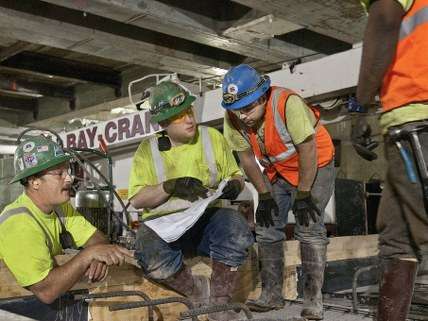U.S. Labor Market Is Losing Flexibility, and That's a Bad Sign For Jobs

Last week we heard from the Bureau of Labor Statistics that job growth in August was disappointing—and that labor force participation is as low as it's been in decades. Last month, a Brookings Institution study said our economy is is increasingly dominated by older, established firms, with a decline in entrepreneurship of the sort that drives innovation and job growth. Now, a paper from Steven Davis of the University of Chicago and John Haltiwanger of the University of Maryland says American job markets have become less fluid. There's less shifting among jobs and reduced "churn" (hiring and firing) at least partially because of increased dominance of the economy by large, established firms. Just as bad, the labor markets are increasingly burdened by regulation. This is a problem, they argue, because "reduced fluidity has harmful consequences for productivity, real wages and employment."
I can't be the only one seeing a pattern here.
Government regulation almost certainly plays a big role in the increased dominance of the U.S. economy by large firms. The Index of Economic Freedom points out, "the overall cost of meeting regulatory requirements has increased by over $60 billion since 2009, with more than 130 new regulations imposed." The Fraser Institute's Economic Freedom of the World: 2013 Annual Report (PDF) is tougher, noting that that "To a large degree, the United States has experienced a significant move away from rule of law and toward a highly regulated, politicized state."
While the Index insists "The labor market…remains flexible," this is not a regulatory environment conducive to the creation of new firms without politicial connections and inexperienced in navigating red tape. It is an environment that advantages large, established firms that can survive the bureaucracy—but which don't make for the fluid job markets that Davis and Haltiwanger find so beneficial.
And there's a real question as to how flexible America's labor markets remain. Davis and Haltiwanger write:
[G]overnment restrictions on who can work in which jobs have expanded greatly over time…the fraction of workers required to hold a government-issued license to do their jobs rose from less than 5 percent in the 1950s to 29 percent in 2008. Adding workers who require government certification, or who are in the process of becoming licensed or certified, brings the share of workers in jobs that require a government-issued license or certification to 38 percent as of 2008.
They add that "the spread of occupational licensing and certification raises the cost of occupational mobility." They also point to other regulations, such as minimum wage rules and the erosion of employment-at-will, which "reduce labor market fluidity, sometimes by design."
The Economist points out that the heavily regulated labor market is a model that has proved disastrous for economic dynamism and the simple ability to make a living elsewhere.
In Spain, for example, centralised wage bargaining and other protections for workers made it difficult for employers to sack permanent employees or cut their wages (these rules were recently eased). Instead, firms hired armies of temporary workers, who bore the brunt of the massive job losses that began in 2007.
America has long been an exception where workers might lose jobs but could easily find new ones—and where it was relatively easy to take risks with the new businesses that created those new jobs. As that changes, we risk sinking into the doldrums that have given Europe such a sluggish economy, and which may have already gained a foothold here.



Show Comments (32)